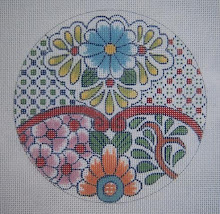 I didn't like the way the Frosty Rays and Flair were looking on the flowers, as they were not the right texture to stand out against the background, so I eliminated that.
I didn't like the way the Frosty Rays and Flair were looking on the flowers, as they were not the right texture to stand out against the background, so I eliminated that.What DID work was the DMC Satin Floss (4ply), as it really shines, and stands out beautifully against the matte finish of the cotton floss.
Also, against the texture of the background being done in T-stitch.
Actually, the leaves are made with Perle Cotton, but could as well be done with floss. I like the subtle shine of this because of the "ropy" twist of the thread. It does make a bit of difference.
The larger flowers on the "lace trim" across the center were made with the same white Satin Floss, but in long, slanted stitches (4-ply), and slanted in different directions to give a bit of dimension to the petals of each flower. You can see this detail if you click to enlarge the picture.
For anyone who missed my little method of stitching with floss, I have used this for about 30 years, and found it extremely helpful in preventing the little individual plies from going astray during stitching. ESPECIALLY with the Satin Floss, which is rayon, and quite slippery. (but well worth the effort) Just take the labels off the skein, open it totally out (first removing all cats from the room) and then put the two ends together. Fold the long thread over three times and cut the looped ends. This produces a long thread, about 38" long or so, but cotton and rayon are both sturdy, and I haven't found it difficult as it doesn't fray. (This long thread doubled after you take off the plies you need, will be a working thread of about 19". It seems long, but is quite easily managed.)
 Then take off two plies (for 18 mesh canvas, 3 plies for 13 mesh), double it, and thread the loop through the eye of the needle. Then put the ends of the thread through the loop, and pull a slip knot up next to the eye.
Then take off two plies (for 18 mesh canvas, 3 plies for 13 mesh), double it, and thread the loop through the eye of the needle. Then put the ends of the thread through the loop, and pull a slip knot up next to the eye. 
This holds the plies securely, and once the stitching has begun, they will lie flat and not separate. If you make a mistake and have to undo a stitch - then you will have to cut off the slip knot. Oh well. It happens, but not often.
This ornament is extremely simple in design, but I thoroughly enjoyed working it, and didn't get bored - probably because of the four different color areas. It was fascinating to stitch just a little bit further and see how the color looked around the next band of flowers - which is one of the reasons I enjoy just drawing a design on white canvas and not painting it.

6 comments:
Thank you so much for your two fantastic tips for working with floss. Shortly after your earlier posting I started using both the slip knot and your technique for folding and cutting the skein into 38" lengths. I find that they make stitching so much more enjoyable and I can make faster progress. I also discovered that rather than cutting the slip knot when I need to unstitch I can loosen the slip knot by poking at it with a different needle and can then remove my stitching needle, pull out the bad stitch or two, then thread my stitching needle back into the slip knot and continue stitching. This also works when I finish an area and still have a length of thread left on my needle and want to save it uncut for future use.
Nice!
What a great tip for working with slippery threads. I usually double mine, but I hadn't thought of snuggling them up with a slip knot!
One of my granddaughters would love this, as it's her favorite color. Thank you for sharing how you choose colors and stitches. We all learn from this. I'm going to try your method of stitching with floss and rayon threads too. It's always good to learn a new technique that will make my stitching more enjoyable!
Hi Judy,
Very pretty!
I also love the new Satin floss. Much nicer than the rayon. :-)
Cynthia
Windy Meadow
Post a Comment